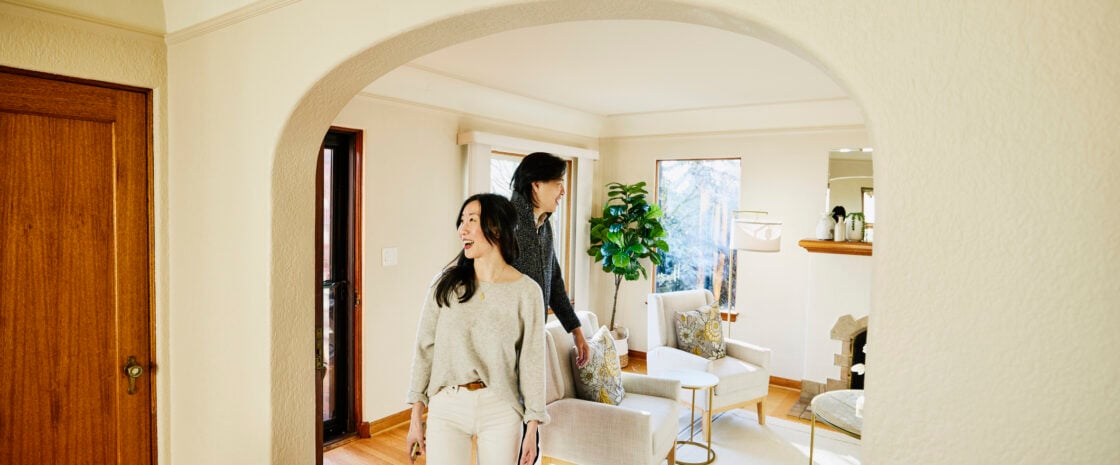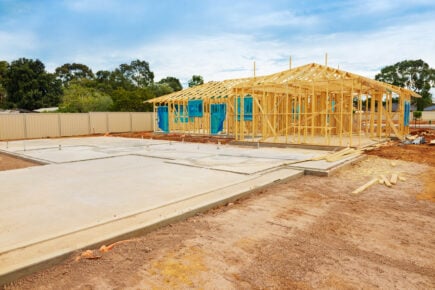Home ownership is considered somewhat of a Holy Grail in Australia, and successive federal and state governments have implemented policies to make buying a home easier. This emphasis has been mainly on younger, first-time home buyers, who often find it nearly impossible to save for a deposit — especially when simultaneously paying rent — and don’t have access to a guarantor.
However, the latest incentive, Help to Buy, expands access to more low- and middle-income Australian families. Here’s what you need to know.
Key takeaways:
- Help to Buy is a proposed federal shared equity scheme that was designed to help 40,000 Australians co-own a home.
- The government will contribute up to 40% towards buying a home.
- Those eligible only have to pay a 2% deposit.
- There is still no official start date or details about where to apply. However, demand is likely to be high, and some lenders are already taking enquiries for waiting lists.
What is the Help to Buy scheme?
Help to Buy is a proposed federal shared equity scheme. The scheme plans to make home ownership available for up to 40,000 additional Australian households through four annual allocations of 10,000 homes.
The government is touting Help to Buy as ‘one of the most significant housing reforms in a generation’. Still, it has already achieved some success with the First Home Owner Grant in 2022, a national initiative to get first home owners into the market through a lump sum payment. The initiative’s rollout differed slightly from state to state but provided a much-needed boost to recipients in their quest for a deposit.
The federal government has also championed a range of other initiatives, such as the First Home Guarantee Scheme and the Family Home Guarantee. However, unlike previous iterations, which were only available to first home buyers, Help to Buy widens the scope. This scheme can be accessed by anyone who doesn’t currently own a property, regardless of whether they’ve already owned one.
What is a shared equity scheme?
A shared equity scheme allows would-be home owners to purchase a property by splitting its equity with the government. Put simply, this means buying your property in partnership with the government. In return, they fund part of the mortgage and own a share in the property equal to its contributions.
Similar initiatives are already up and running at the state level. For example, the HomeBuyer Fund in Victoria, the HomeShare Scheme in WA, and Shared Equity in NSW. Shared Equity is a pilot program that’s available to 6,000 people across two financial years. It is specifically designed for people to buy a property when they would otherwise not be approved for a mortgage. It’s open to single parents, older singles, survivors of domestic violence, and eligible key workers.
» MORE: How to get a home loan
How does Help to Buy work?
Under the Help to Buy scheme, the government will contribute:
- up to 30% of the value of a property for existing homes and
- up to 40% for new homes in exchange for a proportional interest in the property.
As the owner, you won’t need to pay rent for the portion of the home held by the government. You are, however, expected to pay down the government’s equity contribution over time. Alternatively, the government’s share must be paid back in full when the property is sold.
Crucially, those eligible only have to pay a 2% deposit. That means you could buy a property for $800,000 with a deposit of only $16,000. This is far lower than any previous initiative and, potentially, can take years off the process of saving for a deposit.
» MORE: How to build and increase equity in your home
Eligibility for Help to Buy
To be eligible, you will need to:
- be an Australian citizen and at least 18 years of age
- have an annual income of no more than $90,000 for individuals and $120,000 for couples
- not currently own any other land or property in Australia or internationally
- have saved a minimum 2% deposit on the property you wish to purchase
- have proven ability to pay all upfront costs, such as stamp duty, conveyancing and bank fees
- have proven ability to make regular mortgage repayments with a participating lender.
Additionally, applicants must plan to buy a property within a particular price range and live in the property once purchased.
Price caps
Properties eligible for the program must be valued within a particular price range. According to the Help to Buy exposure draft, the following price caps will likely apply once the program is rolled out:
| Area | Price cap |
|---|---|
| New South Wales (capital city and regional centre) | $950,000 |
| New South Wales (other) | $750,000 |
| Victoria (capital city and regional centre) | $850,000 |
| Victoria (other) | $650,000 |
| Queensland (capital city and regional centre) | $700,000 |
| Queensland (other) | $550,000 |
| Western Australia (capital city) | $600,000 |
| Western Australia (other) | $450,000 |
| South Australia (capital city) | $600,000 |
| South Australia (other) | $450,000 |
| Tasmania (capital city) | $600,000 |
| Tasmania (other) | $450,000 |
| Australian Capital Territory | $750,000 |
| Northern Territory | $600,000 |
| Jervis Bay Territory and Norfolk Island | $550,000 |
| Christmas Island and Cocos (Keeling) Islands | $400,000 |
When will Help to Buy come into effect?
Help to Buy is set to come into effect in 2024. However, states must pass their own legislation for it to become operational in their respective jurisdictions. That should only be a formality, as states and territories agreed at a National Cabinet meeting last year to progress the legislation so the scheme can be adopted nationally.
Additionally, there have been some hiccups since the initiative was announced on the May 1, 2022 campaign trail.
Deadline to apply
There is still no official start date or details about where to apply. However, the Exposure Draft for this initiative just completed the consultation process on May 21, 2024. Demand is likely to be high, and some lenders are already taking enquiries for waiting lists.
Pros and cons of Help to Buy
The Help to Buy scheme may seem too good to be true. While the benefits should far outweigh the disadvantages, there are a couple of pitfalls to be wary of before you rush to sign on.
Pros
- Lower deposit: As mentioned above, a 2% deposit is a godsend for those struggling to come up with a much higher and unattainable amount just to get their foot in the door. If you take a $500,000 property as an example, the difference between a 2% deposit ($10,000) and the conventional 20% deposit ($100,000) is a massive savings.
- Easier affordability: Help to Buy makes properties much more affordable because you only have to borrow between 58% and 68% of the principal after you factor in the deposit and the government’s contribution of between 30% and 40% of the property’s value.
- No lenders mortgage insurance: There’s no need to worry about lenders mortgage insurance (LMI) because you contribute well over 20% of the property’s value with the government’s contribution.
- Lower repayments: Lower borrowings mean lower repayments, which frees your funds up to accelerate your repayments further and pay out the government or invest in something else.
- Lower interest rates: You can negotiate a more competitive interest rate if you pay between 32% and 42% of the property’s value upfront.
- Can buy back the government’s share: You can buy back the government’s share 5% at a time. You also won’t be charged rent or interest on the government’s share.
- Achieve home ownership sooner: The Help to Buy Scheme plans to help 40,000 households achieve the great Aussie home ownership dream much faster than would otherwise have been possible.
Cons:
- Conditions: As mentioned above, eligibility conditions, such as salary caps, mean that if you start earning more, you may be asked to pay back the government’s contribution sooner rather than later.
- Price caps: Price caps are higher in metropolitan centres and lower in regional areas, so you can only look for properties within the allotted range.
- Other mortgage expenses: This isn’t a con, but you will still have to pay stamp duty, conveyancing fees and other initial costs of buying a house, plus ongoing expenses related to home ownership.
- May need to refinance: The scheme is for owner-occupiers. If your situation changes and you wish to turn the home into an investment property, you may have to refinance to pay the government out at some point in the future.
Is it worth it?
Given the upsides, the Help to Buy scheme will likely be significantly oversubscribed. So, expect there to be far more applicants than places available. So, you should get your paperwork and apply as soon as more information about a start date becomes available. You could also talk to a mortgage broker or a financial planner about framing your application so it stands out.
DIVE EVEN DEEPER

How ‘Rent To Own’ Home Schemes Work
Rent-to-own schemes are advertised as an easy way to get into the property market, but the risks may not be worth the benefits.

First Home Buyer Tips: 5 Mistakes To Avoid
Enlisting early help from a lending professional, doing neighbourhood-level research, and factoring ongoing costs into your budget are some key tips for first-time home buyers to consider.

What Is A Property Valuation?
A property valuation offers a source of truth when deciding how much a property is worth. Understanding what determines valuations can make you a more informed home buyer, owner or investor, especially if you plan to sell.


